Contaminants of Emerging Concern on Microplastics Found in the Chrysaora chesapeakei of the Patuxent River, Chesapeake Bay, MD
Abstract
1. Introduction
1.1. Concerning Emerging Contaminants (CECs)
1.2. Absorption of Emerging Contaminants by Microplastics
1.3. C. chesapeakei
1.4. Microplastic Movements and C. chesapeakei
1.5. C. chesapeakei with Microplastics and Contaminants of Emerging Concern
2. Materials and Methods
2.1. Sample Collections
2.2. Contamination Prevention
2.3. Raman Scattering Spectroscopy
2.4. Techniques I, II, III, IV
Techniques
3. Method I Results
3.1. Technique I Results
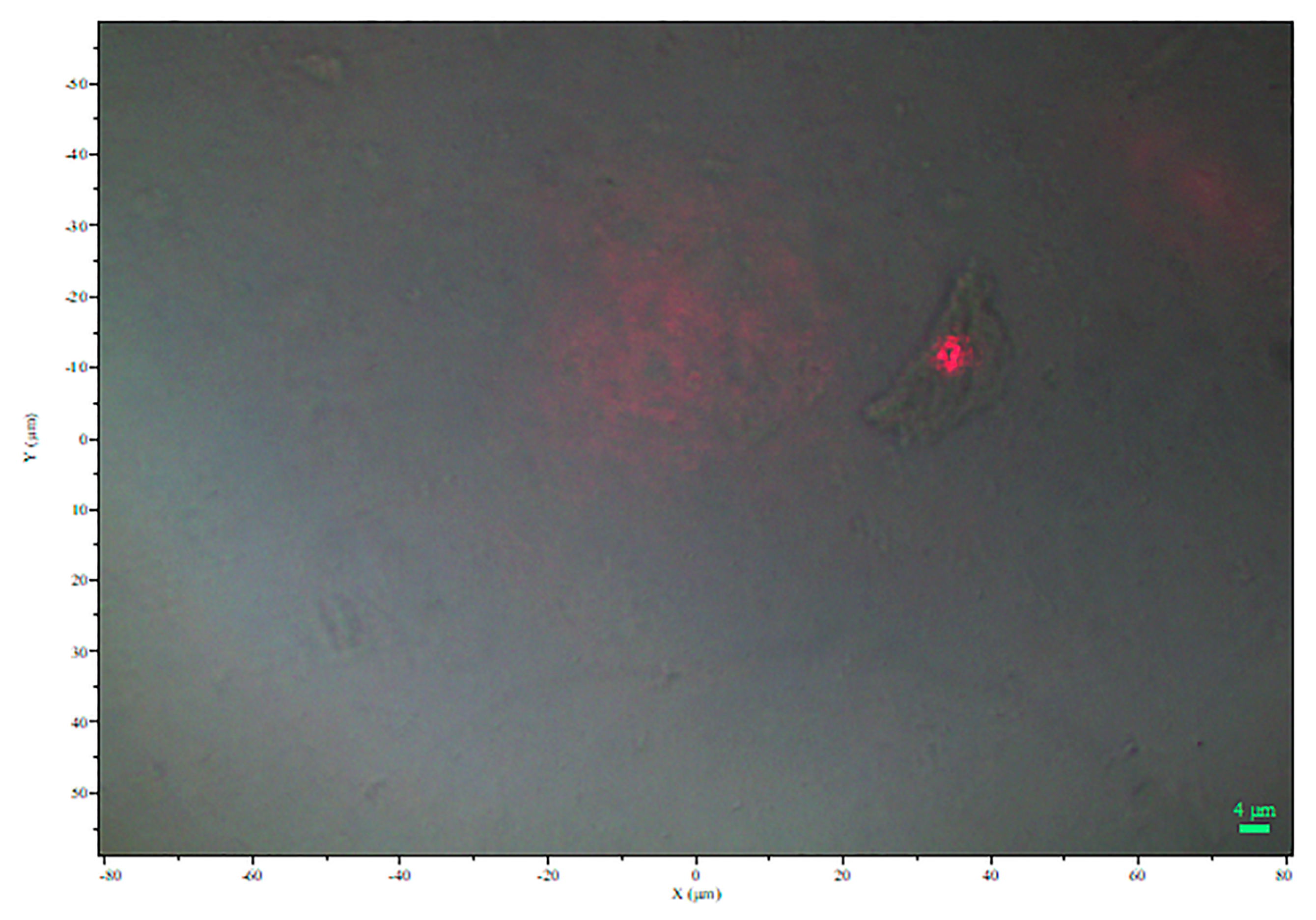
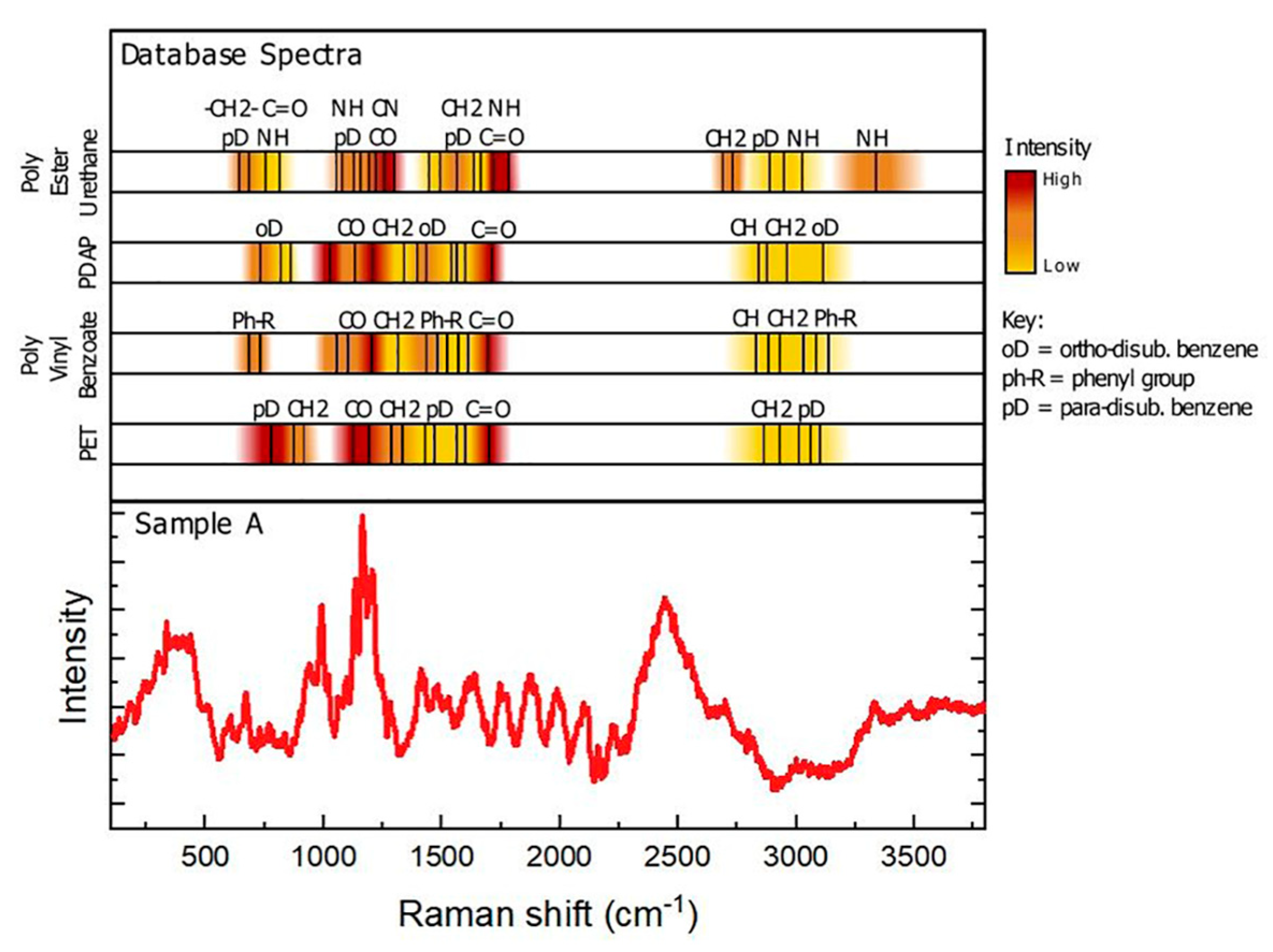
3.2. Technique II Results
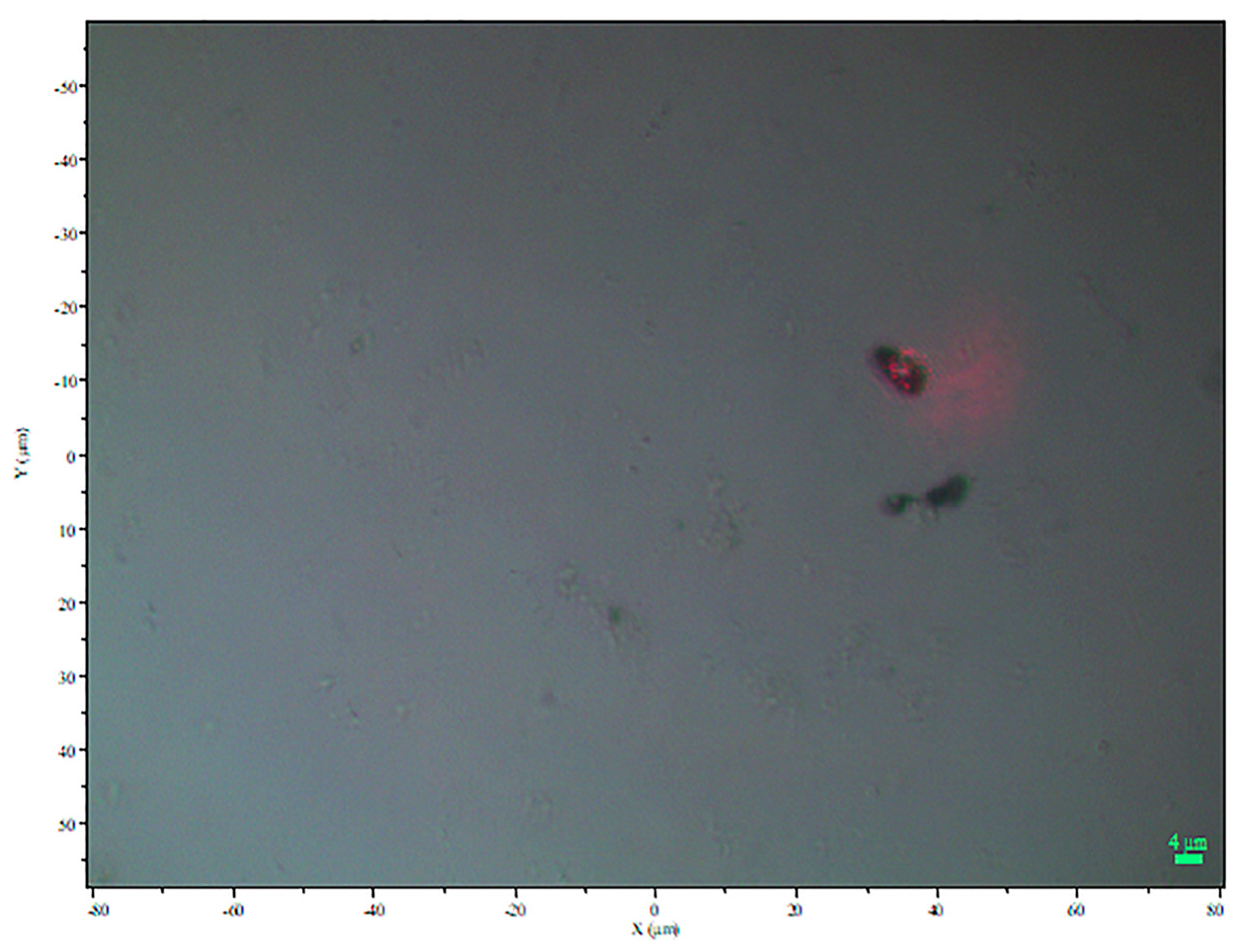

3.3. Technique III Results
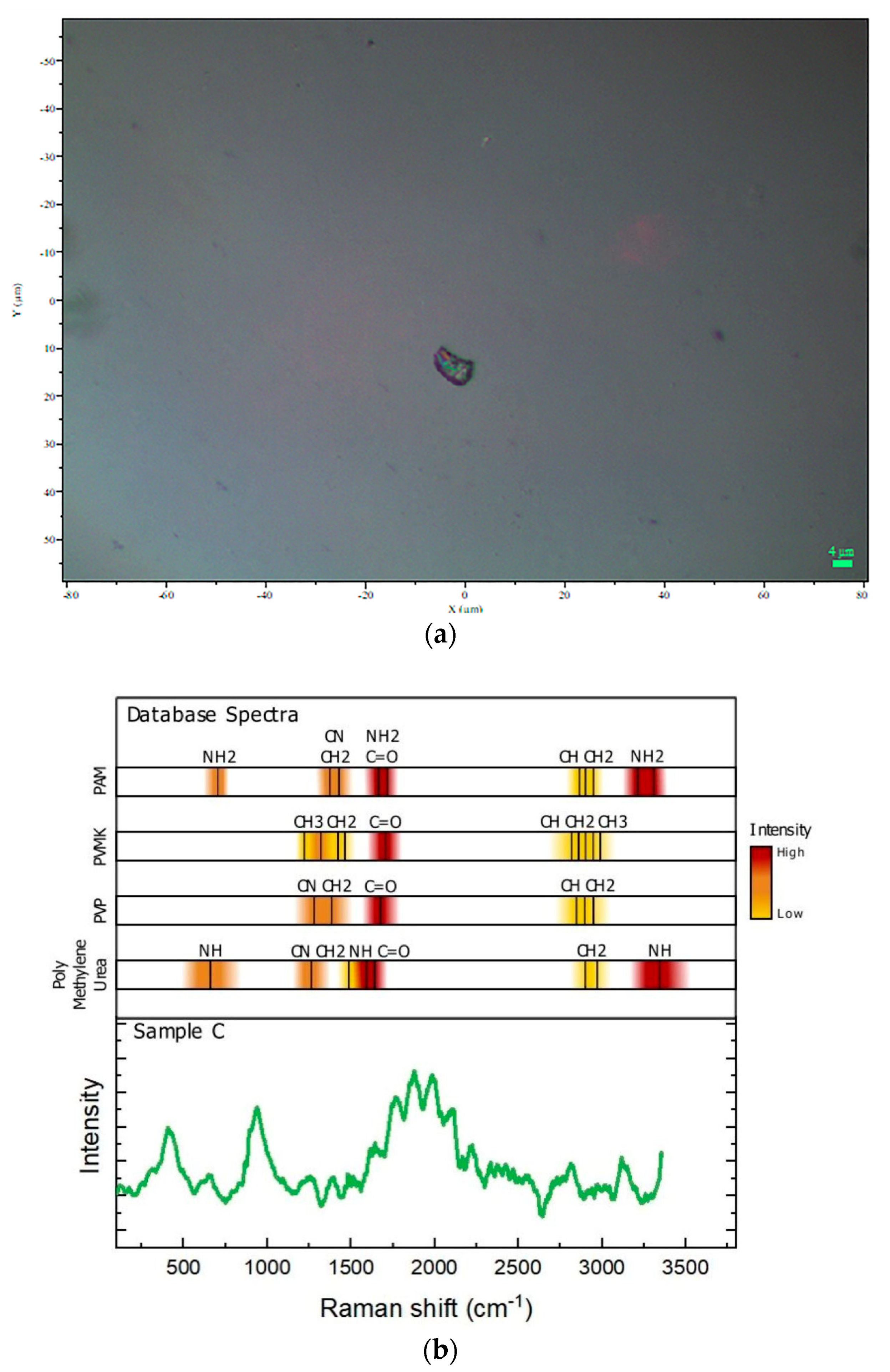
3.4. Technique IV Results
4. Method II Results
4.1. Technique I Results
4.2. Technique II Results
4.3. Technique III Results
5. Discussion
6. Conclusions
Author Contributions
Funding
Institutional Review Board Statement
Informed Consent Statement
Data Availability Statement
Acknowledgments
Conflicts of Interest
References
- Castelvetro, V.; Corti, A.; Bianchi, S.; Ceccarini, A.; Manariti, A.; Vinciguerra, V. Quantification of poly(ethylene terephthalate) micro- and nanoparticle contaminants in marine sediments and other environmental matrices. J. Hazard. Mater. 2019, 385, 121517. [Google Scholar] [CrossRef] [PubMed]
- Avazzadeh Samani, F.; Meunier, L. Interactions of microplastics with contaminants in freshwater systems: A review of characteristics, bioaccessibility, and environmental factors affecting sorption. J. Environ. Sci. Health Part. A 2023, 58, 222–235. [Google Scholar] [CrossRef] [PubMed]
- Bowley, J.; Baker-Austin, C.; Porter, A.; Hartnell, R.; Lewis, C. Oceanic Hitchhikers—Assessing Pathogen Risks from Marine Microplastic. Trends Microbiol. 2020, 29, 107–116. [Google Scholar] [CrossRef]
- Cox, K.D.; Covernton, G.A.; Davies, H.L.; Dower, J.F.; Juanes, F.; Dudas, S.E. Human Consumption of Microplastics. Environ. Sci. Technol. 2019, 53, 7068–7074. [Google Scholar] [CrossRef]
- Mato, Y.; Isobe, T.; Takada, H.; Kanehiro, H.; Ohtake, C.; Kaminuma, T. Plastic resin pellets as a transport medium for toxic chemicals in the marine environment. Env. Sci. Technol. 2001, 35, 318–324. [Google Scholar] [CrossRef]
- Ogata, Y.; Takada, H.; Mizukawa, K.; Hirai, H.; Iwasa, S.; Endo, S.; Mato, Y.; Saha, M.; Okuda, K.; Nakashima, A.; et al. International pellet watch: Global monitoring of persistent organic pollutants (POPs) in coastal waters 1 Initial phase data on PCBs, DDTs, and HCHs. Mar. Pollut. Bull. 2009, 58, 1437–1446. [Google Scholar] [CrossRef]
- Zhang, H.; Wang, J.; Zhou, B.; Zhou, Y.; Dai, Z.; Zhou, Q.; Chriestie, P.; Luo, Y. Enhanced adsorption of oxytetracycline to weathered micro-plastic polystyrene: Kinetics, isotherms and influencing factors. Env. Pollut. 2018, 243, 1550–1557. [Google Scholar] [CrossRef] [PubMed]
- Lu, J.; Wu, J.; Wu, J.; Zhang, C.; Luo, Y. Adsorption and Desorption of Steroid Hormones by Microplastics in Seawater. Bull. Environ. Contam. Toxicol. 2021, 107, 730–735. [Google Scholar] [CrossRef]
- Mortimer, M.; Batley, G. Marine Contaminants of Emerging Concern. In Marine Pollution—Monitoring, Management and Mitigation; Springer Textbooks in Earth Sciences, Geography and Environment; Reichelt-Brushett, A., Ed.; Springer: Cham, Switzerland, 2023. [Google Scholar] [CrossRef]
- Dulio, V.; van Bavel, B.; Brorström-Lundén, E.; Harmsen, J.; Hollender, J.; Schlabach, M.; Slobodnik, J.; Thomas, K.; Koschorreck, J. Emerging pollutants in the EU: 10 years of NORMAN in support of environmental policies and regulations. Env. Sci. Eur. 2018, 30, 5. [Google Scholar] [CrossRef]
- O’Donovan, S.; Mestre, N.C.; Abel, S.; Fonseca, T.G.; Carteny, C.C.; Cormier, B.; Keiter, S.H.; Bebianno, M.J. Ecotoxicological effects of chemical contaminants adsorbed to microplastics in the Clam Scrobicularia plana. Front. Mar. Sci. 2018, 5, 143. [Google Scholar] [CrossRef]
- Verla, A.W.; Enyoh, C.E.; Verla, E.N.; Nwarnorh, K.O. Microplastic-toxic chemical interaction: A review study on quantified levels, mechanism and implication. SN Appl. Sci. 2019, 1, 1400. [Google Scholar] [CrossRef]
- Yu, F.; Yang, C.; Zhu, Z.; Bai, X.; Ma, J. Adsorption behavior of organic pollutants and metals on micro/nanoplastics in the aquatic environment. Sci. Total Environ. 2019, 694, 133643. [Google Scholar] [CrossRef]
- Wang, F.; Zhang, M.; Sha, W.; Wang, Y.; Hao, H.; Dou, Y.; Li, Y. Sorption Behavior and Mechanisms of Organic Contaminants to Nano and Microplastics. Molecules 2020, 25, 1827. [Google Scholar] [CrossRef]
- Li, J.; Zhang, K.; Zhang, H. Adsorption of antibiotics on microplastics. Environ. Pollut. 2018, 237, 460–467. [Google Scholar] [CrossRef]
- Joo, S.H.; Liang, Y.; Kim, M.; Byun, J.; Choi, H. Microplastics with adsorbed contaminants: Mechanisms and Treatment. Environ. Chall. 2021, 3, 100042. [Google Scholar] [CrossRef]
- Alimi, O.S.; Farner Budarz, J.; Hernandez, L.M.; Tufenkji, N. Microplastics and Nanoplastics in Aquatic Environments: Aggregation, Deposition, and Enhanced Contaminant Transport. Environ. Sci. Technol. 2018, 52, 1704–1724. [Google Scholar] [CrossRef] [PubMed]
- Gagliano, E.; Sgroi, M.; Falciglia, P.P.; Vagliasindi, F.G.A.; Roccaro, P. Removal of poly- and perfluoroalkyl substances (PFAS) from water by adsorption: Role of PFAS chain length, effect of organic matter and challenges in adsorbent regeneration. Water Res. 2020, 171, 115381. [Google Scholar] [CrossRef]
- Syberg, K.; Khan, F.R.; Selck, H.; Palmqvist, A.; Banta, G.T.; Daley, J.; Sano, L.; Duhaime, M.B. Microplastics: Addressing ecological risk through lessons learned. Environ. Toxicol. Chem. 2015, 34, 945–953. [Google Scholar] [CrossRef]
- Ziccardi, L.M.; Edgington, A.; Hentz, K.; Kulacki, K.J.; Kane Driscoll, S. Microplastics as vectors for bioaccumulation of hydrophobic organic chemicals in the marine environment: A state-of-the-science review. Environ. Toxicol. Chem. 2016, 35, 1667–1676. [Google Scholar] [CrossRef]
- Dogra, K. Microplastic-Facilitated Transport of Emerging Contaminants in Redox-Active Environments. In Proceedings of the EGU General Assembly 2025, Vienna, Austria, 27 April–2 May 2025; EGU25-17448. [Google Scholar] [CrossRef]
- Chen, Q.; Zhang, H.; Allgeier, A.; Zhou, Q.; Ouellet, J.D.; Crawford, S.E.; Luo, Y.; Yang, Y.; Shi, H.; Hollert, H. Marine microplastics bound dioxin-like chemicals: Model explanation and risk assessment. J. Hazard. Mater. 2019, 364, 82–90. [Google Scholar] [CrossRef] [PubMed]
- Kiessling, T.; Gutow, L.; Thiel, M. Marine litter as habitat and dispersal vector. In Marine Anthropogenic Litter; Bergmann, M., Gutow, L., Klages, M., Eds.; Springer International Publishing AG: Cham, Switzerland, 2015; pp. 141–181. [Google Scholar] [CrossRef]
- Caruso, G. Microplastics as vectors of contaminants. Mar. Pollut. Bull. 2019, 146, 921–924. [Google Scholar] [CrossRef]
- Smith, C.A.; Mandal, S.; Fan, C.; Pramanik, S. Microplastic Volatile Organic Compounds Found within Chrysaora chesapeakei in the Patuxent River, Maryland. Microplastics 2024, 3, 250–263. [Google Scholar] [CrossRef]
- García-Gómez, J.C.; Garrigós, M.; Garrigós, J. Plastic as a Vector of Dispersion for Marine Species With Invasive Potential. A Review. Front. Ecol. Evol. 2021, 9, 629756. [Google Scholar] [CrossRef]
- Americus, B.; Lotan, T.; Bartholomew, J.L.; Atkinson, S.D. A comparison of the structure and function of nematocysts in free-living and parasitic cnidarians (Myxozoa). Int. J. Parasitol. 2020, 50, 763–769. [Google Scholar] [CrossRef]
- Thorington, G.U.; Hessinger, D.A. Efferent Mechanisms of Discharging Cnidae: II. A Nematocyst Release Response in the Sea Anemone Tentacle. Biol. Bull. 1998, 195, 145–155. [Google Scholar] [CrossRef]
- Wei, X.-F.; Bohlén, M.; Lindblad, C.; Hedenqvist, M.; Hakonen, A. Microplastics generated from a biodegradable plastic in freshwater and seawater. Water Res. 2021, 198, 117123. [Google Scholar] [CrossRef]
- NOAA. What Are Jellyfish Bodies Made from? What Are Jellyfish Made of? NOAA: Washington, DC, USA, 2023.
- Purcell, J.E.; Decker, M.B. Effects of Climate on Relative Predation by Scyphomedusae and Ctenophores on Copepods in Chesapeake Bay during 1987–2000. Limnol. Oceanogr. 2005, 50, 376–387. [Google Scholar] [CrossRef]
- Morabito, R.; Marino, A.; La Spada, G. Nematocytes’ activation in Pelagia noctiluca (Cnidaria, Scyphozoa) oral arms. J. Comp. Physiol. A Neuroethol. Sens. Neural Behav. Physiol. 2012, 198, 419–426. [Google Scholar] [CrossRef]
- Morabito, R.; Marino, A.; Dossena, S.; La Spada, G. Nematocyst discharge in Pelagia noctiluca (Cnidaria, Scyphozoa) oral arms can be affected by lidocaine, ethanol, ammonia and acetic acid. Toxicon Off. J. Int. Soc. Toxinology 2014, 83, 52–58. [Google Scholar] [CrossRef]
- Ormond, R.; Caldwell, S. The effect of oil pollution on the reproduction and feeding behavior of the sea anemone Actinia equina. Mar. Pollut. Bull. 1982, 13, 118–122. [Google Scholar] [CrossRef]
- Available online: https://www.seatemperature.org/north-america/united-states/solomons.htm (accessed on 10 March 2024).
- Smith, C.; Denaro, F.; Fan, C.; Pramanik, S. The Effective Use of the Inexpensive LED Microscope with Rhodamine Blue Staining to Identify Microplastics. Microsc. Today 2023, 31, 36–37. [Google Scholar] [CrossRef]
- Sauls-Smith, C.A.; Pramanik, S.; Drichko, N.; Fan, C. The Occurrence of Microplastics in Chrysaora Chesapeakei in the Patuxent River, Maryland; Science Symposium Morgan State University: Baltimore, MD, USA, 2022. [Google Scholar]
- Gemmell, B.J.; Du Clos, K.T.; Colin, S.P.; Sutherland, K.R.; Costello, J.H. The most efficient metazoan swimmer creates a ‘virtual wall’ to enhance performance. Proc. Biol. Sci. 2021, 288, 20202494. [Google Scholar] [CrossRef] [PubMed]
- Dong, M.; Zhang, Q.; Xing, X.; Chen, W.; She, Z.; Luo, Z. Raman spectra and surface changes of microplastics weathered under natural environments. Sci. Total Environ. 2020, 739, 139990. [Google Scholar] [CrossRef] [PubMed]
- Hildebrandt, L.; Zimmermann, T.; Primpke, S.; Fischer, D.; Gerdts, G.; Pröfrock, D. Comparison and uncertainty evaluation of two centrifugal separators for microplastic sampling. J. Hazard. Mater. 2021, 414, 125482. [Google Scholar] [CrossRef]
- Cai, H.; Xu, E.G.; Du, F.; Li, R.; Liu, J.; Shi, H. Analysis of environmental nanoplastics: Progress and challenges. Chem. Eng. J. 2021, 410, 128208. [Google Scholar] [CrossRef]
- Medina Faull, L.E.; Zaliznyak, T.; Taylor, G.T. Assessing diversity, abundance, and mass of microplastics (~ 1–300 μm) in aquatic systems. Limnol. Oceanogr. Methods 2021, 19, 369–384. [Google Scholar] [CrossRef]
- Oseji, O.F.; Fan, C.; Chigbu, P. Composition and Dynamics of Phytoplankton in the Coastal Bays of Maryland, USA, Revealed by Microscopic Counts and Diagnostic Pigments Analyses. Water 2019, 11, 368. [Google Scholar] [CrossRef]
- Hirose, E.; Sakai, D.; Iida, A.; Obayashi, Y.; Nishikawa, J. Exumbrellar Surface of Jellyfish: A Comparative Fine Structure Study with Remarks on Surface Reflectance. Zool. Sci. 2021, 38, 170–178. [Google Scholar] [CrossRef]
- Britannica, T. Editors of Encyclopedia (1 April 2009). Epithelium. Encyclopedia Britannica. Available online: https://www.britannica.com/science/epithelium (accessed on 10 March 2024).
- Hydrophobic Interactions. (2023, January 30). Hydrophobic Interactions is Shared Under a CC BY-SA 4.0 License and was Authored, Remixed, and/or Curated by Justin Than. Available online: https://chem.libretexts.org/@go/page/1506 (accessed on 10 March 2024).
- Gall, S.C.; Thompson, R.C. The impact of debris on marine life. Mar. Pollut. Bull. 2015, 92, 170–179. [Google Scholar] [CrossRef]
- Wu, Y.; Wang, S.; Wu, L.; Yang, Y.; Yu, X.; Liu, Q.; Liu, X.; Li, Y.; Wang, X. Vertical distribution and river-sea transport of microplastics with tidal fluctuation in a subtropical estuary, China. Sci. Total Environ. 2022, 822, 153603. [Google Scholar] [CrossRef]
- Morgan, C.; Owens, N. Benefits of water quality policies: The Chesapeake Bay. Ecol. Econ. 2001, 39, 271–284. [Google Scholar] [CrossRef]
- Hain, E.; He, K.; Batista-Andrade, J.A.; Feerick, A.; Tarnowski, M.; Timm, A.; Blaney, L. Geospatial and co-occurrence analysis of antibiotics, hormones, and UV filters in the Chesapeake Bay (USA) to confirm inputs from wastewater treatment plants, septic systems, and animal feeding operations. J. Hazard. Mater. 2023, 460, 132405. [Google Scholar] [CrossRef]
- Arikan, O.A.; Rice, C.; Codling, E. Occurrence of antibiotics and hormones in a major agricultural watershed. Desalination 2008, 226, 121–133. [Google Scholar] [CrossRef]
- McClure, C.M.; Smalling, K.L.; Blazer, V.S.; Sperry, A.J.; Schall, M.K.; Kolpin, D.W.; Phillips, P.J.; Hladik, M.L.; Wagner, T. Spatiotemporal variation in occurrence and co-occurrence of pesticides, hormones, and other organic contaminants in rivers in the Chesapeake Bay Watershed, United States. Sci. Total Environ. 2020, 728, 138765. [Google Scholar] [CrossRef]
- Apeti, D.A.; Wirth, E.F.; Leight, A.; Mason, A.L.; Pisarski, E. An assessment of contaminants of emerging concern in Chesapeake Bay, MD and Charleston Harbor, SC. NOAA Tech. Memo. NOS NCCOS 2018, 240, 104. [Google Scholar] [CrossRef]
- Dorabawila, N.; Gupta, G. Endocrine disrupter—estradiol—in Chesapeake Bay tributaries. J. Hazard. Mater. 2005, 120, 67–71. [Google Scholar] [CrossRef]
- Waseem, H.; Williams, M.R.; Stedtfeld, R.D.; Hashsham, S.A. Antimicrobial Resistance in the Environment. Water Environ. Res. 2017, 89, 921–941. [Google Scholar] [CrossRef]
- Thompson, T.J.; Briggs, M.A.; Phillips, P.J.; Blazer, V.S.; Smalling, K.L.; Kolpin, D.W.; Wagner, T. Groundwater discharges as a source of phytoestrogens and other agriculturally derived contaminants to streams. Sci. Total Environ. 2021, 755, 142873. [Google Scholar] [CrossRef] [PubMed]
- Pait, A.S.; Warner, R.A.; Hartwell, S.I.; Pacheco, P.A.; Mason, A.L. Human Use Pharmaceuticals in the Estuarine Environments: A Survey in the Chesapeake and Biscayne Bays. NOAA Tech. Memo. NOS NCCOS 2006, 21. Available online: https://coastalscience.noaa.gov/data_reports/human-use-pharmaceuticals-in-the-estuarine-environments-a-survey-in-the-chesapeake-and-biscayne-bays/ (accessed on 10 March 2024).
- Iwanowicz, L.R.; Blazer, V.S.; Guy, C.P.; Pinkney, A.E.; Mullican, J.E.; Alvarez, D.A. Reproductive health of bass in the Potomac, USA, drainage: Part 1. Exploring the effects of proximity to wastewater treatment plant discharge. Env. Toxicol. Chem. Int. J. 2009, 28, 1072–1083. [Google Scholar] [CrossRef] [PubMed]
- Wang, L.; Bank, M.S.; Rinklebe, J.; Hou, D. Plastic–Rock Complexes as Hotspots for Microplastic Generation. Environ. Sci. Technol. 2023, 57, 7009–7017. [Google Scholar] [CrossRef] [PubMed]
- Zandieh, M.; Patel, K.; Liu, J. Adsorption of Linear and Spherical DNA Oligonucleotides onto Microplastics. Langmuir ACS J. Surf. Colloids 2022, 38, 1915–1922. [Google Scholar] [CrossRef] [PubMed]
- Data-Patuxent Sentinel: Chesapeake Biological Laboratory Pier Monitoring Program. Available online: https://cblmonitoring.umces.edu/ (accessed on 10 March 2024).
- Yee, M.S.; Hii, L.W.; Looi, C.K.; Lim, W.M.; Wong, S.F.; Kok, Y.Y.; Tan, B.K.; Wong, C.Y.; Leong, C.O. Impact of Microplastics and Nanoplastics on Human Health. Nanomaterials 2021, 11, 496. [Google Scholar] [CrossRef]
- Kozlov, M. Landmark study links microplastics to serious health problems. Nature 2024. [Google Scholar] [CrossRef] [PubMed]
- Wang, X.; Tian, S. Microplastics and Nanoplastics in Atheromas. N. Engl. J. Med. 2024, 390, 1727. [Google Scholar] [CrossRef]
- Braun, A.; Seitz, H. Uptake and Cellular Effects of Polymethylmethacrylate on Human Cell Lines. Microplastics 2024, 3, 205–216. [Google Scholar] [CrossRef]
- Müller, N.D.; Kirtane, A.; Schefer, R.B.; Mitrano, D.M. eDNA Adsorption onto Microplastics: Impacts of Water Chemistry and Polymer Physiochemical Properties. Environ. Sci. Technol. 2024, 58, 7588–7599. [Google Scholar] [CrossRef]
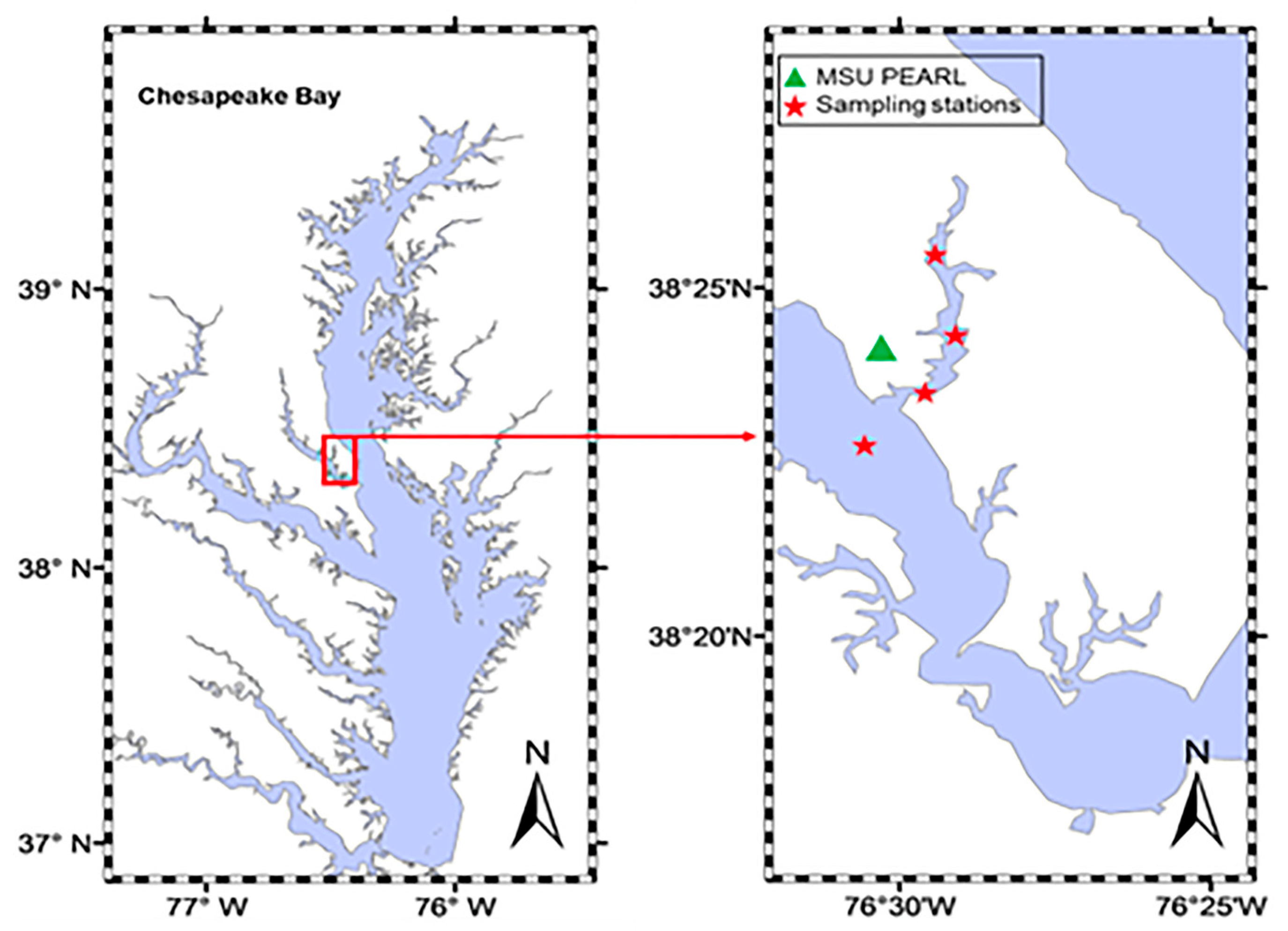

 MP” column represents how many times the molecules appeared on the MP extracted.
MP” column represents how many times the molecules appeared on the MP extracted.
 MP” column represents how many times the molecules appeared on the MP extracted.
MP” column represents how many times the molecules appeared on the MP extracted.| Concerning Emerging Contaminant | Tech | µ MP | Uses |  MP MP |
|---|---|---|---|---|
| Deuterium Oxide | I | 0.23 | microplastics, pharmeceutical additives, DNA labeling | 50 |
| Ferric phosphate tetrahydrate | I | 0.26 | agriculture, ceramics, and wastewater treatment | 49 |
| 3-Chloro-6 hydrazinopyridazine | I | 0.19 | agrochemical research, synthesizing various drugs and pesticides | 30 |
| Sulfasalazine | I | 0.2 | considered a disease-modifying anti-rheumatic drug, pharmeceuticals | 28 |
| Sodium hexametaphophate | I | 0.22 | food emulsifier, softener | 14 |
| 7-Hydroxcoumarin-4-acetic acid | I | 0.2 | pharmeucetical and biochemistry | 10 |
| Trichlomethiazide | I | 0.24 | pharmeceutical, diuretic | 5 |
| 3,5 Dichlorobenzenesulfonyl chloride | I | 0.16 | used to prepare organic compounds such as medicines, dyes, and pesticides | 4 |
| 5-(4-Morpholinyl)-2-nitrophenol | I | 0.28 | pharmaceuticals, analgesics, soluble sulfanilamides | 3 |
| Stronium titanate | I | 0.11 | a diamond simulant, mineral, man made | 3 |
| 4-Fluoro-2-(trifluoromethyl) benzenesulfonyl chloride | I | 0.13 | pharmaceutical, agrochemical, or material science | 2 |
| 6,7-Dihydroxycoumain-4-acetic acid | I | 0.11 | biological and pharmaceutical, sunscreens, and inhibits cancers cell | 2 |
| Bromopentafluoroacetone | I | 0.15 | pharmaceuticals, agrochemicals, and specialty chemicals | 2 |
| Clorsulon | I | 0.09 | veterinary medicine for the treatment of liver fluke, worms | 2 |
| Indole-3- pyruvic acid | I | 0.085 | in mice, reduces diarrhea, colonic inflammation, expression of certain genes. | 2 |
| p-Chlorolphenoxy acetic acid | I | 0.16 | synthetic pesticide | 2 |
| Phenethyl caffeiate | I | 0.11 | antineoplastic, anti-inflammatory antioxidant, an antiviral agent, antibacterial | 2 |
| Zinc trifluoromethanesulfonate | I | 0.15 | mineral | 2 |
| 3,4 Difluorobenzenesulfonamide | I | 0.09 | synthesis of pharmaceuticals, agrochemicals, and other organic | 1 |
| 1,(4-Methylphenyl)piperazine | I | 0.08 | pharmeceutical | 1 |
| 1,4,6-Pragnatrien-3,20-dione | I | 0.08 | pharmeceuticals, forensics | 1 |
| 2-(4-Bromophenyl) | I | 0.1 | flame retardant | 1 |
| 4-Pregnen-11B,17,21-triol-3,20-dione | I | 0.08 | Hydrocortisone | 1 |
| 4,6-Estradien-3,17-dione | I | 0.11 | estrogenic, non-aromatic steroid, minor estrogenic effects required in males | 1 |
| 5-Chloro-2-methoxybenzenesulfonyl | I | 0.15 | pharmeceuticals | 1 |
| 5-Methyl resorcinol monohydrate | I | 0.15 | pharmeceuticals | 1 |
| 6-Chloronicotinic acid | I | 0.15 | agrochemicals, animal food enrichment, and food additives, pharmeceuticals | 1 |
| Calcium titanate | I | 0.19 | ceramics, ores of titanium | 1 |
| Clopidol | I | 0.08 | veterinary medicine as a coccidiostat | 1 |
| Sodium bis(trifluoromethanesulfonyl)imide | I | 0.1 | electrolyte in batteries and fuel cells | 1 |
| Sulfamide | I | 0.15 | antibiodic, nonantibiodic, pharmeceutical | 1 |
| Zirconium Silicate | I | 0.13 | enamels, and ceramic glazes, occurs in nature as mineral zircon | 1 |
 MP column represents how many times the molecules appeared on the MP extracted.
MP column represents how many times the molecules appeared on the MP extracted.
 MP column represents how many times the molecules appeared on the MP extracted.
MP column represents how many times the molecules appeared on the MP extracted.| Concerning Emerging Contaminants | Tech | µ MP | Uses |  MP MP |
|---|---|---|---|---|
| 2-(bromomethyl)-1,4 bis(trifluoromethyl) benzene | II | 0.11 | PFAS and sometimes referred to as "forever chemicals | 1 |
| 2-Acetylpyrrole | II | 0.13 | It is used as a food additive in items such as cocoa, rum, brandy, and caramel | 1 |
| 2-Aminopyridine-4-carboxylic acid | II | 0.16 | agrochemicals and pharmaceuticals. | 1 |
| 2-Bromo-4-methoxy-6-nitrophenol | II | 0.14 | chemical properties, making it a versatile intermediate in various industrial applications. | 1 |
| 2-Deoxyctidine-5-monophosphate | II | 0.28 | synthesis of DNA and RNA and commonly produced by bacteria E.coli geneses in the wild | 36 |
| 2-Methyl-4-nirtoaniline | II | 0.35 | aniline compound used in the synthesis of dyes and pigments | 36 |
| 4-[(E)-1,3-Thiazol-2-uldiazenyl]-1,3-benzenediol | II | 0.14 | pharmaceutical affiliate | 1 |
| 4-Amino-2-nitrophenol | II | 0.16 | pH indicator, synthesis of dyes, wood preservatives, photographic developers, and explosives | 1 |
| 4-Nitrophenylhydrazine | II | 0.32 | exhibits potential anticancer activity and acts as a derivatizing agent for carbonyl compounds | 3 |
| 4,5-Dichloro-2-nitroaniline | II | 0.15 | used in industrial settings and as a component in materials such as flooring, furniture, and toys | 1 |
| 5-Chloro-4-methyl-2-nitroaniline | II | 0.16 | starting material for the production of dyes, pharmaceuticals, and some pesticides | 2 |
| 6-Mercaptopurine monohydrate | II | 0.14 | used to treat acute lymphoblastic or lymphocytic leukemia and used to treat cancers | 1 |
| 6-Methyl-2-nitro-3-pyrindinol | II | 0.2 | a chemical intermediate in the synthesis related to pharmaceuticals and materials science | 1 |
| Barium Anhydrous | II | 0.13 | manufacturing, analytical chemistry, and testing | 1 |
| Barium Pyrovanadate | II | 0.17 | hard, ductile transition metal, primarily used as a steel additive | 1 |
| Benzimidazole-5-6-dicarboxylic acid | II | 0.15 | agrochemical, pharmaceutical, and dyestuff field | 1 |
| Cromophtal Violet B | II | 0.1 | organic pigment for coloring PVC, PO, PS, PET, rubber, PUR and PP. Also used in fibers. | 1 |
| Cyclocreatine | II | 0.08 | antiviral, antidiabetic, protect tissues from hypoxic, ischemic, neurodegenerative or muscle damage | 1 |
| Diethylenetriamine pentaacetic acid | II | 0.09 | inactive ingredients for drug products by the FDA, DPTA was developed by the pharmaceutical company | 1 |
| Dumorterite | II | 0.23 | minerals used in the manufacture of high grade porcelain. | 39 |
| EDTA. dipotassium salt dihydrate | II | 0.13 | textiles | 1 |
| Furazolidone | II | 0.12 | oral treatment against bacterial and protozoal infections | 1 |
| Methyl 3-isothiocyanatopropionate | II | 0.09 | chemical intermediate in the development of agrochemicals and pharmaceuticals, | 1 |
| Methyl difluoroacetate | II | 0.08 | fruity-smelling liquid used as an intermediate in the synthesis of pharmaceuticals and agrochemicals | 1 |
| p-(p-Phenylene terephthalamide) | II | 0.12 | reinforcing composites in rubber industries, such as hoses, conveyor belts, tires, and rubber tracks | 1 |
| Poly(acetal) reinforced | II | 0.13 | polyformaldehyde, is an engineering thermoplastic used in precision parts | 1 |
| Poly(dimethylolurea) | II | 0.08 | Antimicrobial characteristics, wood treatment, textile finishing, tanning and photographic developers | 1 |
| Propyleneimine | II | 0.1 | chemical is used in the paper, textile, rubber and pharmaceutical industries, paint | 1 |
| Salvinorin A | II | 0.13 | hallucinogen, unique pharmacological effects on opioid receptors, | 1 |
| Thallium acetate | II | 0.14 | selective agent against gram-negative bacteria in selective media for the detection of mollicute | 1 |
| Triacetin | II | 0.11 | cosmetic biocide (most often as a fungicide), plasticizer, food additive (as a flavoring agent and adjuvant), | 1 |
| Tungstic acid | II | 0.1 | mordant and a dye in textiles | 1 |
 MP” column represents how many times the molecules appeared on the MP extracted.
MP” column represents how many times the molecules appeared on the MP extracted.
 MP” column represents how many times the molecules appeared on the MP extracted.
MP” column represents how many times the molecules appeared on the MP extracted.| Concerning Emerging Contaminants | Tech | µ | Uses |  |
|---|---|---|---|---|
| 1,1,2-Trichlorotrifluoroethane | III | 0.11 | refrigerant, a dry cleaning solvent, an extraction solvent for petroleum hydrocarbons, oils, and greases | 1 |
| Adamite | III | 0.13 | zinc arsenate hydroxide mineral, | 2 |
| Aluminum Sulfate | III | 0.14 | coagulating agent purification of drinking water, wastewater treatment plants, paper manufacturing | 1 |
| Amblygonite | III | 0.08 | phosphate mineral with lithium and fluorine, often found in granite pegmatite | 1 |
| Ammonium magnesium chloride hexaydrate | III | 0.15 | dehydrated to form anhydrous magnesium chloride, which is used in various industrial processes | 1 |
| Ammonium sodium phosphate dibasic tetra | III | 0.15 | employed in the food industry as a food additive, | 1 |
| Aniline sulfate | III | 0.12 | manufacturing of polyurethan plastics, paracetamol, acetaminophen, Tylenol, pesticide and fungicide. | 16 |
| Beryl | III | 0.11 | mineral composed of beryllium aluminium silicate | 1 |
| Beryllonite | III | 0.09 | phosphate mineral | 1 |
| Carundum(sapphire) | III | 0.09 | mineral | 1 |
| Diopse | III | 0.08 | rare mineral occurring as emerald green or blue-green crystals made of hydrated silicate of copper | 1 |
| Enstatite | III | 0.11 | a mineral composed of Magnesium | 3 |
| Epidote | III | 0.13 | aluminum-iron mineral that can be found in either crystal or stone form | 1 |
| Euclase | III | 0.12 | beryllium aluminium hydroxide silicate mineral | 2 |
| Forsterite | III | 0.15 | magnesium-rich olivine mineral that forms in igneous and metamorphic rocks | 2 |
| Fuamaryl chloride | III | 0.13 | chemical intermediate used in the production of pharmaceuticals, dyestuffs, and insecticides | 37 |
| Lead sulfate | III | 0.16 | a sulfate of lead that can occur naturally as the mineral anglesite, and often in lead-acid batteries | 2 |
| Methylbenzoylecgonine HCl | III | 0.09 | major metabolite of cocaine | 1 |
| Phenakite | III | 0.18 | mineral made of of beryllium orthosilicate | 1 |
| Phosphoric acid solution | III | 0.16 | produced from phosphate rock | 1 |
| Poly(chlorotrifluoroethylene | III | 0.08 | is a thermoplastic chlorofluoropolymer | 1 |
| Pyromorphite | III | 0.35 | mineral species composed of lead chlorophosphate | 42 |
| Rutile | III | 0.15 | an oxide mineral composed of titanium dioxide (TiO2), the most common natural form of TiO2. | 3 |
| Seripierite | III | 0.23 | rare, sky-blue coloured hydrated sulfate mineral, often found as a post-mining product | 2 |
| Titanite | III | 0.11 | titanium mineral accessaory to granitic and calcium rich metamorphic rock | 2 |
| Zinc borate | III | 0.15 | flame retardant in plastics and cellulose fibers, paper, rubbers and textiles, paints, adhesives, pigments | 7 |
Disclaimer/Publisher’s Note: The statements, opinions and data contained in all publications are solely those of the individual author(s) and contributor(s) and not of MDPI and/or the editor(s). MDPI and/or the editor(s) disclaim responsibility for any injury to people or property resulting from any ideas, methods, instructions or products referred to in the content. |
© 2025 by the authors. Licensee MDPI, Basel, Switzerland. This article is an open access article distributed under the terms and conditions of the Creative Commons Attribution (CC BY) license (https://creativecommons.org/licenses/by/4.0/).
Share and Cite
Smith, C.A.; Drichko, N.; Lorenzo, M.; Pramanik, S. Contaminants of Emerging Concern on Microplastics Found in the Chrysaora chesapeakei of the Patuxent River, Chesapeake Bay, MD. Microplastics 2025, 4, 32. https://doi.org/10.3390/microplastics4020032
Smith CA, Drichko N, Lorenzo M, Pramanik S. Contaminants of Emerging Concern on Microplastics Found in the Chrysaora chesapeakei of the Patuxent River, Chesapeake Bay, MD. Microplastics. 2025; 4(2):32. https://doi.org/10.3390/microplastics4020032
Chicago/Turabian StyleSmith, Carol A., Natalie Drichko, Miranda Lorenzo, and Saroj Pramanik. 2025. "Contaminants of Emerging Concern on Microplastics Found in the Chrysaora chesapeakei of the Patuxent River, Chesapeake Bay, MD" Microplastics 4, no. 2: 32. https://doi.org/10.3390/microplastics4020032
APA StyleSmith, C. A., Drichko, N., Lorenzo, M., & Pramanik, S. (2025). Contaminants of Emerging Concern on Microplastics Found in the Chrysaora chesapeakei of the Patuxent River, Chesapeake Bay, MD. Microplastics, 4(2), 32. https://doi.org/10.3390/microplastics4020032






